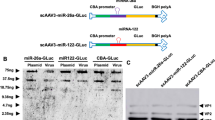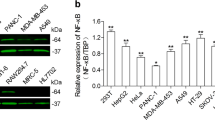Abstract
Hepatocellular carcinoma (HCC) is a prevalent malignant tumour with high global morbidity and mortality associated with its multiple aetiologies, poor prognosis, resistance to chemotherapeutic drugs and high rate of recurrence. Here, we evaluated a gene therapy strategy that targets HCC using the herpes simplex virus thymidine kinase/ganciclovir (HSVtk/GCV) suicide gene system in HCC cell lines and in an in vivo human HCC xenograft mouse model. Apolipoprotein E (ApoE)-modified liposomes were used for targeted gene delivery to the tumour tissue, and the survivin promoter was used to drive HSVtk expression in HCC cells. Our results showed that the survivin promoter was specifically activated in tumour cells, and HSVtk was expressed selectively in tumour cells. In combination with GCV treatment, HSVtk expression resulted in the inhibition of HCC cell proliferation via enhanced apoptosis. In addition, tail vein injection of ApoE-HSVtk significantly suppressed the growth of xenograft tumours through an apoptosis-dependent pathway and extended the survival time of tumour-bearing mice. In summary, this study illustrates an effective cancer-specific gene therapy strategy for HCC that can be further developed for future clinical trials.
This is a preview of subscription content, access via your institution
Access options
Subscribe to this journal
Receive 12 print issues and online access
$259.00 per year
only $21.58 per issue
Buy this article
- Purchase on Springer Link
- Instant access to full article PDF
Prices may be subject to local taxes which are calculated during checkout








Similar content being viewed by others
References
Li W, Wang Y, Kellner DB, Zhao L, Xu L, Gao Q. Efficacy of RetroNectin-activated cytokine-induced killer cell therapy in the treatment of advanced hepatocelluar carcinoma. Oncol Lett. 2016;12:707–14.
Siegel RL, Miller KD, Jemal A. Cancer Statistics, 2017. CA. 2017;67:7–30.
Lee SC, Tan HT, Chung MC. Prognostic biomarkers for prediction of recurrence of hepatocellular carcinoma: current status and future prospects. World J Gastroenterol. 2014;20:3112–24.
Xiao J, Zhang G, Li B, Wu Y, Liu X, Tan Y, et al. Dioscin augments HSV-tk-mediated suicide gene therapy for melanoma by promoting connexin-based intercellular communication. Oncotarget. 2017;8:798–807.
Al Hossain J, Ystaas L, Talasila KM, Riecken K, Fehse B, Bjerkvig R, et al. Long-term treatment with valganciclovir improves lentiviral suicide gene therapy for glioblastoma. Neuro-Oncology. 2017;19(suppl_3):iii63.
Wang Z, Chang Z, Lu M, Shao D, Yue J, Yang D, et al. Shape-controlled magnetic mesoporous silica nanoparticles for magnetically-mediated suicide gene therapy of hepatocellular carcinoma. Biomaterials. 2017;154:147–57.
Ding B, Li T, Zhang J, Zhao L, Zhai G. Advances in liver-directed gene therapy for hepatocellular carcinoma by non-viral delivery systems. Curr Gene Ther. 2012;12:92–102.
Wang S, Huang R. Non-viral nucleic acid delivery to central nervous system and brain tumor. J Gene Med. 2019;21:e3091.
Yu BF, Wu J, Zhang Y, Sung HW, Xie J, Li RK. Ultrasound-targeted HSVtk and Timp3 gene delivery for synergistically enhanced antitumor effects in hepatoma. Cancer Gene Ther. 2013;20:290–7.
Sun W, Wang Y, Cai M, Lin L, Chen X, Cao Z, et al. Codelivery of sorafenib and GPC3 siRNA with PEI-modified liposomes for hepatoma therapy. Biomater Sci. 2017;5:2468–79.
Alton EW, Boyd AC, Porteous DJ, Davies G, Davies JC, Griesenbach U, et al. A phase I/IIa safety and efficacy study of nebulized liposome-mediated gene therapy for cystic fibrosis supports a multidose trial. Am J Respiratory Crit Care Med. 2015;192:1389–92.
Khumsupan P, Ramirez R, Khumsupan D, Narayanaswami V, Apolipoprotein E. LDL receptor-binding domain-containing high-density lipoprotein: a nanovehicle to transport curcumin, an antioxidant and anti-amyloid bioflavonoid. Biochim Biophys Acta. 2011;1808:352–9.
Julien O, Wells JA. Caspases and their substrates. Cell Death Differ. 2017;24:1380–9.
Diaz-Gonzalez A, Forner A, Rodriguez de Lope C, Varela M. New challenges in clinical research on hepatocellular carcinoma. Rev Espanola de enfermedades digestivas: organo oficial de la Soc Espanola de Patologia Digestiva. 2016;108:485–93.
Lima PH, Fan B, Berube J, Cerny M, Olivie D, Giard JM, et al. Cost-utility analysis of imaging for surveillance and diagnosis of hepatocellular carcinoma. AJR Am J Roentgenol. 2019;213:1–9.
Rahbari NN, Mehrabi A, Mollberg NM, Muller SA, Koch M, Buchler MW, et al. Hepatocellular carcinoma: current management and perspectives for the future. Ann Surg. 2011;253:453–69.
Liu ZJ, Huang Y, Wei L, He JY, Liu QY, Yu XQ, et al. Combination of LINE-1 hypomethylation and RASSF1A promoter hypermethylation in serum DNA is a non-invasion prognostic biomarker for early recurrence of hepatocellular carcinoma after curative resection. Neoplasma. 2017;64:795–802.
Wang DG, Zhao MJ, Liu YQ, Liu XW, Niu HT, Song YF, et al. Fiber-modified adenovirus-mediated suicide gene therapy can efficiently eliminate bladder cancer cells in vitro and in vivo. Oncotarget. 2016;7:71710–7.
Ohmori T. Development of gene therapy for hemophilia: current states and future perspectives. [Rinsho ketsueki] Jpn J Clin Hematol. 2018;59:2238–46.
Wirth T, Yla-Herttuala S. Gene therapy used in cancer treatment. Biomedicines. 2014;2:149–62.
Rangel-Sosa MM, Aguilar-Cordova E, Rojas-Martinez A. Immunotherapy and gene therapy as novel treatments for cancer. Colomb Med. 2017;48:138–47.
Karjoo Z, Chen X, Hatefi A. Progress and problems with the use of suicide genes for targeted cancer therapy. Adv Drug Deliv Rev. 2016;99:113–28.
Rooseboom M, Commandeur JN, Vermeulen NP. Enzyme-catalyzed activation of anticancer prodrugs. Pharmacol Rev. 2004;56:53–102.
Ingemarsdotter CK, Poddar S, Mercier S, Patzel V, Lever AML. Expression of herpes simplex virus thymidine kinase/Ganciclovir by RNA trans-splicing induces selective killing of HIV-producing cells. Mol Ther Nucleic Acids. 2017;7:140–54.
Kubo M, Satoh T, Tabata KI, Tsumura H, Iwamura M, Baba S, et al. Enhanced central memory cluster of differentiation 8(+) and tumor antigen-specific T cells in prostate cancer patients receiving repeated in situ adenovirus-mediated suicide gene therapy. Mol Clin Oncol. 2015;3:515–21.
Cho HS, Lee HR, Kim MK. Bystander-mediated regression of murine neuroblastoma via retroviral transfer of the HSV-TK gene. J Korean Med Sci. 2004;19:107–12.
Maatta AM, Samaranayake H, Pikkarainen J, Wirth T, Yla-Herttuala S. Adenovirus mediated herpes simplex virus-thymidine kinase/ganciclovir gene therapy for resectable malignant glioma. Curr Gene Ther. 2009;9:356–67.
Chiu CC, Kang YL, Yang TH, Huang CH, Fang K. Ectopic expression of herpes simplex virus-thymidine kinase gene in human non-small cell lung cancer cells conferred caspase-activated apoptosis sensitized by ganciclovir. Int J Cancer. 2002;102:328–33.
Vile RG, Hart IR. Use of tissue-specific expression of the herpes simplex virus thymidine kinase gene to inhibit growth of established murine melanomas following direct intratumoral injection of DNA. Cancer Res. 1993;53:3860–4.
Della Peruta M, Badar A, Rosales C, Chokshi S, Kia A, Nathwani D, et al. Preferential targeting of disseminated liver tumors using a recombinant adeno-associated viral vector. Hum Gene Ther. 2015;26:94–103.
Chen SH, Ji YX, Lian Q, Wen YL, Shen HB, Jia NQ. Gold nanorods coated with multilayer polyelectrolyte as intracellular delivery vector of antisense oligonucleotides. Nano Biomedicine Eng. 2010;2:15–23.
Ji J, Ruan J, Cui D. Advances of nanotechnology in the stem cells research and development. Nano Biomedicine Eng. 2010;2:67–89.
Yin H, Kanasty RL, Eltoukhy AA, Vegas AJ, Dorkin JR, Anderson DG. Non-viral vectors for gene-based therapy. Nat Rev Genet. 2014;15:541–55.
Taratula O, Garbuzenko OB, Kirkpatrick P, Pandya I, Savla R, Pozharov VP, et al. Surface-engineered targeted PPI dendrimer for efficient intracellular and intratumoral siRNA delivery. J Control Release. 2009;140:284–93.
Zhang W, Peng F, Zhou T, Huang Y, Zhang L, Ye P, et al. Targeted delivery of chemically modified anti-miR-221 to hepatocellular carcinoma with negatively charged liposomes. Int J Nanomed. 2015;10:4825–36.
Chen L, Liu Y, Wang W, Liu K. Effect of integrin receptor-targeted liposomal paclitaxel for hepatocellular carcinoma targeting and therapy. Oncol Lett. 2015;10:77–84.
Motoyama K, Nakashima Y, Aramaki Y, Hirayama F, Uekama K, Arima H. In vitro gene delivery mediated by asialofetuin-appended cationic liposomes associated with gamma-cyclodextrin into hepatocytes. J Drug Deliv. 2011;2011:476137.
Trusca VG, Fuior EV, Fenyo IM, Kardassis D, Simionescu M, Gafencu AV. Differential action of glucocorticoids on apolipoprotein E gene expression in macrophages and hepatocytes. PLoS ONE. 2017;12:e0174078.
Mahley RW. Apolipoprotein E: cholesterol transport protein with expanding role in cell biology. Science. 1988;240:622–30.
Luo M, Liu YJ, Xia LM, Yan W, Zhu Q, Tian DA. Very low density lipoprotein receptor subtype II silencing by RNA interference inhibits cell proliferation in hepatoma cell lines. Hepato-Gastroenterol. 2010;57:882–90.
Qu L, Jiang M, Li Z, Pu F, Gong L, Sun L, et al. Inhibitory effect of biosynthetic nanoscale peptide Melittin on hepatocellular carcinoma, driven by survivin promoter. J Biomed Nanotechnol. 2014;10:695–706.
Wang Z, Zhou X, Li J, Liu X, Chen Z, Shen G, et al. Suppression of hepatoma tumor growth by systemic administration of the phytotoxin gelonin driven by the survivin promoter. Neoplasma. 2013;60:469–79.
Teagle AR, Birchall JC, Hargest R. Gene therapy for pyoderma gangrenosum: optimal transfection conditions and effect of drugs on gene delivery in the HaCaT cell line using cationic liposomes. Ski Pharmacol Physiol. 2016;29:119–29.
Ehlert JE, Kubbutat MH. Apoptosis and its relevance in cancer therapy. Onkologie. 2001;24:433–40.
Kim YH, Kim KT, Lee SJ, Hong SH, Moon JY, Yoon EK, et al. Image-aided suicide gene therapy utilizing multifunctional hTERT-targeting adenovirus for clinical translation in hepatocellular carcinoma. Theranostics. 2016;6:357–68.
Zimmerman O, Rogowski O, Aviram G, Mizrahi M, Zeltser D, Justo D, et al. C-reactive protein serum levels as an early predictor of outcome in patients with pandemic H1N1 influenza A virus infection. BMC Infect Dis. 2010;10:288.
Li YF, Yuan YY, Zhang YM, Zhao N, Zhang Q, Meng FX, et al. HSVtk/GCV system on hepatoma carcinoma cells: construction of the plasmid pcDNA3.1pAFP-TK and targeted killing effect. Mol Med Rep. 2017;16:764–72.
Zhang SJ, Chen HY, Chen ZX, Wang XZ. Possible mechanism for hepatitis B virus X gene to induce apoptosis of hepatocytes. World J Gastroenterol. 2005;11:4351–6.
Farese RV Jr., Flynn LM, Young SG. Modification of the apolipoprotein B gene in HepG2 cells by gene targeting. J Clin Investig. 1992;90:256–61.
Acknowledgements
This work was supported by the National Natural Science Foundation of China (30901821, 81172136), International Science and Technology Cooperation Project of Shanxi provincial Key R&D Program (201703D421023,201703D421023), Natural Science Foundation of Shanxi province (2015011113), Shanxi Youth Science and Technology Research Fund (201801D221059, 201801D221069), the Fund for Shanxi “1331 Project” Key Subjects Construction and the Fund for Shanxi Key Subjects Construction.
Author information
Authors and Affiliations
Corresponding authors
Ethics declarations
Conflict of interest
The authors declare that they have no conflict of interest.
Additional information
Publisher’s note Springer Nature remains neutral with regard to jurisdictional claims in published maps and institutional affiliations.
Rights and permissions
About this article
Cite this article
Mu, X., Wang, X., Wei, Y. et al. ApoE-modified liposomes mediate the antitumour effect of survivin promoter-driven HSVtk in hepatocellular carcinoma. Cancer Gene Ther 27, 754–767 (2020). https://doi.org/10.1038/s41417-019-0145-3
Received:
Revised:
Accepted:
Published:
Issue Date:
DOI: https://doi.org/10.1038/s41417-019-0145-3
This article is cited by
-
Suicide gene strategies applied in ovarian cancer studies
Cancer Gene Therapy (2023)



